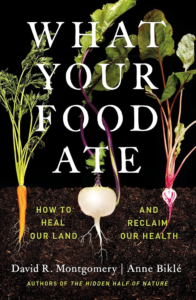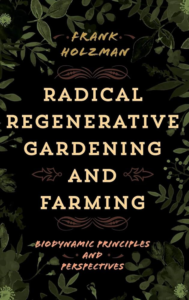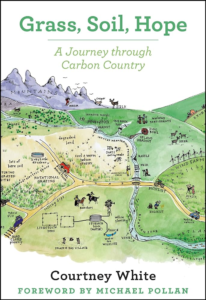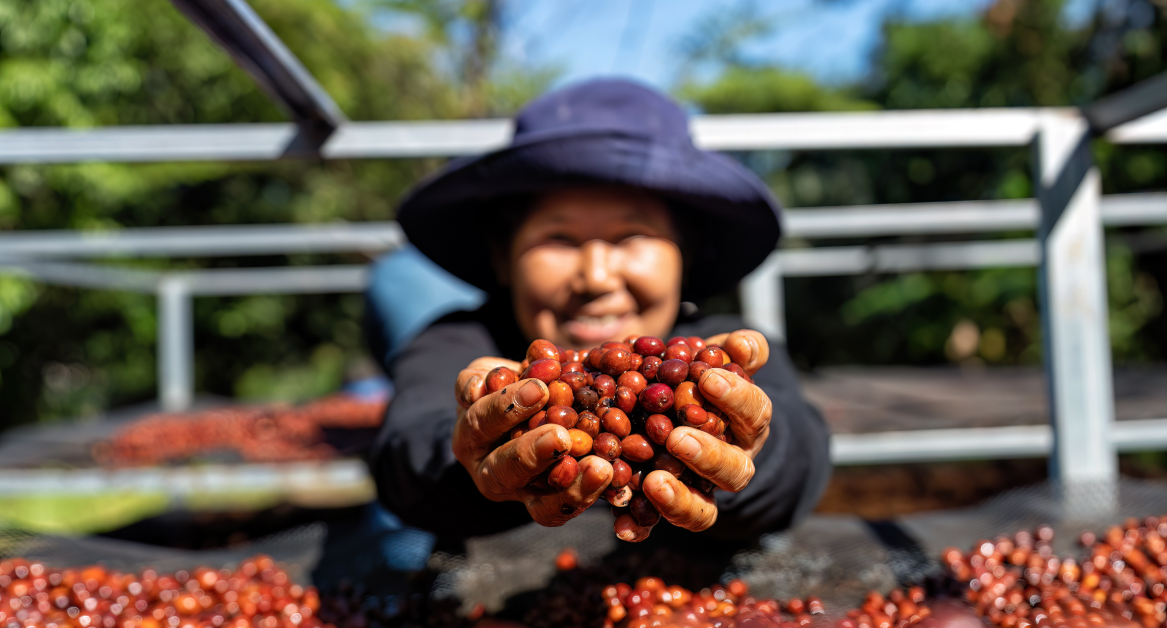Regenerative agriculture is changing the way we think about farming and food. This approach prioritizes soil health and ecosystem balance, offering a path to combat climate change and promote biodiversity.
Our selection of the top 20 books on regenerative agriculture provides a comprehensive look into this transformative practice with insights and best Regen Ag practices from leading experts and practitioners.
Let’s explore these essential reads that are shaping the future of agriculture.
✨ Too busy for a book? Check out the best regenerative agriculture podcasts to follow and listen to.
20 books on regenerative agriculture
1. Dirt to Soil: One Family’s Journey into Regenerative Agriculture
✍ Author(s): Gabe Brown

Source: Amazon
“Dirt to Soil” recounts Gabe Brown’s practical transition from conventional to regenerative farming on his North Dakota farm. His approach, which emphasizes soil health and ecosystem balance, has earned him the Heinz Award for the Environment in 2021, recognizing his leadership in the agricultural community.
The book provides readers with five key lessons on regenerative practices, the importance of soil diversity, and the economic advantages of marketing directly to consumers. Brown’s experience offers valuable insights for farmers and agriculturists aiming to implement sustainable and profitable practices on their own land.
2. Restoration Agriculture: Real-World Permaculture for Farmers
✍ Author(s): Mark Shepard
Mark Shepard’s “Restoration Agriculture” draws from his extensive experience at New Forest Farm, showcasing a successful model of commercial-scale perennial agriculture. The book discusses Shepard’s creation of a farming system that mimics nature and emphasizes the cultivation of perennial plants. This approach has received acclaim in the field of sustainability.
His work has been foundational in the regenerative agriculture movement, combining mechanical engineering with ecology to develop innovative systems for sustainable farming. Shepard’s achievements in transforming degraded land into a thriving farm have been recognized with an award, further cementing the book’s value to both practitioners and advocates of regenerative agriculture.
3. The Hidden Half of Nature: The Microbial Roots of Life and Health
✍ Author(s): David R. Montgomery and Anne Biklé
In “The Hidden Half of Nature,” geologist David R. Montgomery and biologist Anne Biklé offer a compelling book that intertwines the restoration of their own garden with broader ecological insights. They illuminate the critical role microbes play in both soil and human health, drawing an intriguing parallel between garden ecology and human biology.
The book is known for its easy-to-understand writing that connects science with everyday readers. It offers a new way of looking at how we can improve farming and healthcare by studying and nurturing helpful microorganisms.
The Unsettling of America: Culture & Agriculture
✍ Author(s): Wendell Berry
“The Unsettling of America” is Wendell Berry’s seminal work, first published in 1977, where he critiques the industrial agricultural complex and its impact on American society. Berry, a respected cultural critic and farmer, uses his profound understanding of the land to argue for the importance of agricultural vitality to the fabric of the nation.
His views have stood the test of time, resonating with current sustainability discussions. Berry’s influence and contributions to literature and ecology have been recognized with the National Humanities Medal awarded by President Obama in 2010, reflecting the enduring significance of his work.
4. What Your Food Ate: How to Heal Our Land and Reclaim Our Health
✍ Author(s): David R. Montgomery and Anne Biklé

Source: Amazon
This book by Montgomery and Biklé, finalists for the 2023 IACP Award for Food Issues & Matters, explores the significant impact of soil health on the nutritional quality of food and, consequently, human health. They advocate for regenerative farming practices as a solution to the degradation caused by conventional agriculture, emphasizing the intricate connection between the health of the soil and the health of people
5. Regeneration: Ending the Climate Crisis in One Generation
✍ Author(s): Paul Hawken
Paul Hawken’s “Regeneration” offers a blueprint for combating climate change through a holistic approach to restoring planetary health. The book outlines practical strategies for carbon containment and sustainable living without the jargon, making it accessible to a broad audience. Hawken, who has received numerous honorary doctorates and the Green Cross Millennium Award for Individual Environmental Leadership, draws on contributions from various experts to present a vision for a regenerated world
Regenerative Agriculture: A Practical Whole Systems Guide to Making Small Farms Work
✍ Author(s): Richard Perkins
Richard Perkins provides a straightforward approach to creating and managing small-scale farms using regenerative practices. The guide is comprehensive, covering ecological, practical, personal, and financial aspects of farming. It emphasizes restoring soil health, benefiting local communities, and achieving profitability.
6. Wilding: The Return of Nature to a British Farm
✍ Author(s): Isabella Tree
“Wilding” is Isabella Tree’s account of the pioneering rewilding project at Knepp Castle, which transformed an intensively farmed estate into a thriving ecosystem. The book has been celebrated with the Richard Jefferies Society Literature Award and shortlisted for the Wainwright Prize. It’s also been honored with a ZSL Silver Medal and named by Smithsonian Magazine as one of the top ten science books of 2018.
7. Radical Regenerative Gardening and Farming
✍ Author(s): Frank Holzman

Source: Amazon
In “Radical Regenerative Gardening and Farming,” Frank Holzman leverages over four decades of expertise in organic horticulture to guide readers through sustainable land use and biodynamic principles.
The book emphasizes a spiritual connection with the earth, advocating for transformative practices that regenerate and balance ecosystems rather than traditional farming. It’s a resource-rich narrative blending horticulture with ecological stewardship, aimed at both backyard gardeners and professional farmers seeking a deeper engagement with their land
8. English Pastoral: An Inheritance
✍ Author(s): James Rebanks
“English Pastoral” by James Rebanks is a poignant examination of the evolution of British farming through the lens of three generations on a small family farm. The book, winner of the Wainwright Prize for Nature Writing in 2021, is both a personal memoir and a manifesto calling for a shift towards more sustainable agricultural practices.
Rebanks’ point of view is structured around ‘Nostalgia’, ‘Progress’, and ‘Utopia’, reflecting the transition from traditional to industrialized farming and proposing a hopeful vision for the future of agriculture.
9. The Carbon Farming Solution: A Global Toolkit of Perennial Crops and Regenerative Agriculture Practices for Climate Change Mitigation and Food Security
✍ Author(s): Eric Toensmeier
In “The Carbon Farming Solution,” Eric Toensmeier, a permaculture expert, presents a comprehensive guide to regenerative agriculture practices that can mitigate climate change and advance food security. This book explores agroforestry methods that capture carbon and offers practical advice for landscapers and farmers.
10. Growing a Revolution: Bringing Our Soil Back to Life
✍ Author(s): David R. Montgomery

Source: Amazon
David R. Montgomery’s “Growing a Revolution” sheds light on regenerative farming as a means to rejuvenate the world’s soil, enhance food production, and slow climate change.
As a MacArthur Fellow and a professor of geomorphology, Montgomery combines scientific research with global observations to argue for soil health as a foundation for sustainable agriculture. The book suggests that regenerative practices like no-till planting and diverse cropping can significantly improve yields and reduce the need for chemical inputs, contributing to a greener future
11. “One Size Fits None: A Farm Girl’s Search for the Promise of Regenerative Agriculture”
✍ Author(s): Stephanie Anderson
In “One Size Fits None,” Stephanie Anderson, who grew up on a ranch, embarks on a cross-country journey to explore the transformative practices of regenerative agriculture.
Anderson’s book, which won a 2019 Midwest Book Award for Nature, critiques the unsustainable methods of the modern corporate food system and highlights the innovative techniques used by farmers she meets. Anderson demonstrates regenerative agriculture’s promise for repairing public health and the planet.
12. For the Love of Soil: Strategies to Regenerate Our Food Production Systems
✍ Author(s): Nicole Masters
Nicole Masters, an agroecologist and soil advocate, offers a practical guide for regenerating soil and revitalizing food systems in “For the Love of Soil.” The book translates complex soil science into understandable terms, featuring case studies from regenerative practitioners across Australasia and North America. Masters provides readers with actionable steps for land managers to enhance their soil’s health and productivity.
💡 Read more: Exploring Sustainable Agriculture Examples Around the Globe
13. The Soil Will Save Us: How Scientists, Farmers, and Foodies are Healing the Soil to Save the Planet
✍ Author(s): Kristin Ohlson
Kristin Ohlson’s “The Soil Will Save Us” is a compelling book that brings soil and its trillions of microorganisms to the forefront of the climate change conversation. Named by the Los Angeles Times as “a hopeful book and a necessary one,” it details how healthy soil practices can sequester carbon and counter our greenhouse-gas problems.
In the book, Ohlson explores the elegant interplay between plants and soil, delivering a message that resonates with the importance of soil health for greener farms.
14. Grass, Soil, Hope: A Journey Through Carbon Country
✍ Author(s): Courtney White

Source: Amazon
Courtney White’s “Grass, Soil, Hope” takes an optimistic stance on the global warming crisis, suggesting that increasing the carbon content in soil could be a key solution. From his experience as an activist and a nonprofit ranch founder, White explores innovative soil management practices that can reduce atmospheric carbon dioxide and improve food quality.
The book also showcases how proper land stewardship can sequester significant amounts of carbon and contribute to a healthier planet.
15. The Farm as Ecosystem: Tapping Nature’s Reserve—Biology, Geology, Diversity
✍ Author(s): Jerry Brunetti
Jerry Brunetti’s “The Farm as Ecosystem” delves into the interconnectedness of biology, geology, and diversity on the farm. Highlighting the role of mycorrhizal fungi in plant health and defense, the book offers insight into natural solutions for pest and disease control that enhance a plant’s immune system.
Brunetti paints a clear vision of agriculture free from corporate and chemical dependency, focusing on soil structure, mineral content, and biodiversity. His work is a guide to understanding complex soil science and its practical applications for a sustainable and resilient agricultural system
16. “Holistic Management (Third Edition): A Commonsense Revolution to Restore Our Environment”
✍ Author(s): Allan Savory with Jody Butterfield
Allan Savory’s “Holistic Management” offers a systems-thinking approach for resource management, challenging conventional views on livestock grazing and climate change. This updated edition revitalizes Savory’s methods for reversing desertification and restoring grassland soils, emphasizing that the mismanagement of resources is a critical issue.
17. Soil Science for Regenerative Agriculture: A Comprehensive Guide to Living Soil, No-till Gardening, Composting and Natural Farming
✍ Author(s): Amélie des Plantes
Amélie des Plantes’ “Soil Science for Regenerative Agriculture” provides a guide to enhancing soil quality and embracing regenerative agriculture as a solution to numerous environmental issues, including climate change.
Addressing soil erosion, biodiversity loss, and the decline in crop quality, the book emphasizes the immense benefits of regenerative agriculture—ranging from producing nutrient-dense food to combating climate change.



